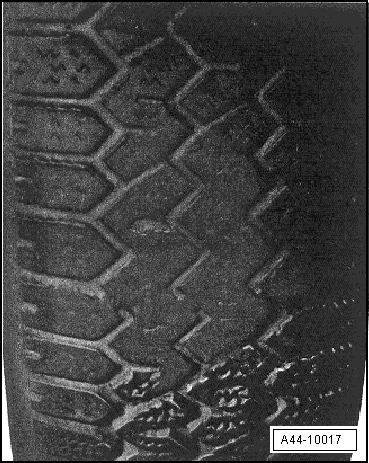Volkswagen Golf Service & Repair Manual: Flat spots (from locking wheels)
| Flat spots can result from an extreme brake application
which causes the wheels to lock, so that the rubber is worn off
at the contact patch between the tread and the road surface. |
| As the tyres slide over the road surface, friction generates
heat, which also reduces the wear resistance of the tread
material. |
| Not even a highly wear-resistant tread compound can prevent
the flat spots caused by violent braking. |
| Even ABS-controlled brake systems cannot prevent brief
locking of the wheels, and thus, minor flat spots. |
| The degree of such wear depends largely on the vehicle
speed, the road surface and the load placed on the wheel. The
following examples should make this clear. |
| If a vehicle is braked to a standstill on a dry surface with
the wheels locked, the amount of rubber worn from the tyre will
cover an area the size of a postcard and will have a thickness
of: |
| up to 2.0 mm from a speed of 57 km/h (23.8 m braking
distance) |
| up to 3.3 mm from a speed of 75 km/h (41.8 m braking
distance) |
| up to 4.8 mm from a speed of 92 km/h (71.6 m braking
distance) |
|
|
|
| Tyres with such damage must no longer be used and must be
renewed. |
|
|

|
Tyre noise that can be heard by the human ear is caused by
vibrations which are transmitted by the air from the source of
the sound to our ears.
...
Other materials:
Storage, transportation and disposal of airbag, belt tensioner and battery
isolator units (pyrotechnic components)
Storage must comply with the relevant national legislation.
Transportation is subject to national and international
regulations that govern packaging, marking, labelling and
freight documentation in detail.
...
Symbols in the roof
Symbol
Meaning
,
,
, ,
Buttons for interior and reading lights .
Switch for the electric panorama sliding/tilting roof
.
...
Disconnecting and connecting battery, vehicles with high-voltage system
Caution
Observe the following instructions and precautions
on safety when working on pyrotechnic components:
Contrary to the following description, the battery
must be disconnected ...
© 2016-2025 Copyright www.vwgolf.org

 General notes on tyre noise
General notes on tyre noise

